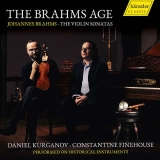Die beiden Interpreten wurden zwar in Weißrussland bzw. Russland geboren, leben aber seit langem in den USA und formen auch schon länger ein Duo. Auf historischen Instrumenten widmen sie sich den drei Sonaten von Johannes Brahms. Das eröffnet ein neues Hören und auch eine neue Herangehensweise.
Kurganov spielt eine Guarneri mit authentischen Rohdarm-Saiten, Finehouse hat originale Klaviere aus dem 19. Jahrhundert zur Verfügung gehabt. Letztere bieten mit geringerer Lautstärke und einem weicheren, mitunter auch weniger prägnant spitzem Ton einen nicht so auf die Geige eindringenden Partner, so dass beide Musiker ohne forciertes Spiel auskommen.
Für den Geiger bedeutet Brahms Verletzlichkeit und ein Höchstmaß an einheitlichem Ausdruck, und insbesondere die Sonaten sind Wandteppiche, die aus Herz und Geist gewebt sind. Bei dem Zusammenspiel mit diesen Instrumenten wird die Umsetzung eines solchen ebenen Bildes unterstützt. Trotzdem gelingt es den beiden Interpreten, ein mehrdimensionales Gebilde zu schaffen, dass das Interesse an den Interpretationen aufrechterhält. Nur in ganz wenigen Momenten der ersten Sonate stechen unvermittelt einige scharfe Töne aus diesen Klangwogen heraus. Ansonsten aber setzen sie das Wandteppichbild in Töne um.
Die feine Musikalität des Duos ist in dieser Aufnahme durchgehend zu erleben. Sie nutzen die Möglichkeiten ihrer Instrumente aus. Dabei formen sie ihre Darstellung so, dass weder Pathos entsteht noch die Freude an der Musik untergeht. Obwohl die Aufnahme keine Spielgeräusche hören lässt, vermittelt sie eine lebendige Unmittelbarkeit. Mit dramatischer Musikalität zeigen sie zusammen die Brahms-Sonaten. Der Ausdruck bleibt elegant und unsentimental.
The two performers were born in Belarus and Russia, respectively, but have long lived in the U.S. and have also formed a duo for some time. On historical instruments they dedicate themselves to the three sonatas by Johannes Brahms. This opens up a new way of listening and also a new approach. Kurganov plays a Guarneri with authentic raw gut strings, Finehouse has had original 19th century pianos at his disposal. The latter, with lower volume and a softer, sometimes less incisively pointed tone, provide a partner that is not as intrusive on the violin, so both musicians can get by without any forced playing.
For the violinist, Brahms means vulnerability and the highest degree of unified expression, and the sonatas in particular are tapestries woven of heart and spirit. The interplay with these instruments supports the realization of such a level picture. Nevertheless, the two performers succeed in creating a multi-dimensional structure that sustains interest in the interpretations. Only in very few moments of the first sonata do a few sharp notes abruptly stick out of these sound waves. Otherwise, however, they translate the picture of a tapestry into tones.
The duo’s fine musicality can be experienced throughout this recording. The performers fully exploit the possibilities of their instruments. In doing so, they shape their performance in a way that neither creates pathos nor drowns the joy of the music. Although the recording allows no playing sounds to be heard, it conveys a vivid immediacy. Together they perform the Brahms sonatas with dramatic musicality. The expression remains elegant and unsentimental.
























